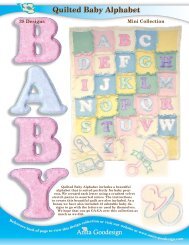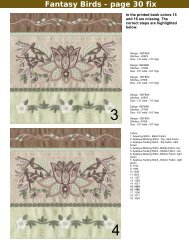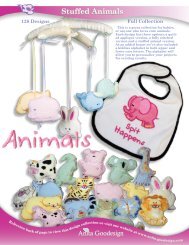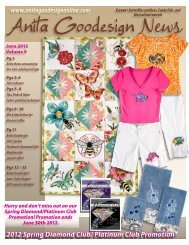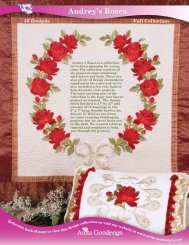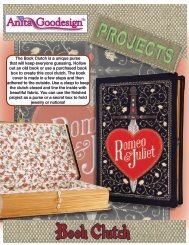mix and match quilt tutorial - Anita Goodesign
mix and match quilt tutorial - Anita Goodesign
mix and match quilt tutorial - Anita Goodesign
You also want an ePaper? Increase the reach of your titles
YUMPU automatically turns print PDFs into web optimized ePapers that Google loves.
Mix <strong>and</strong> Match QuiltsAfter the applique is trimmed, return the hoop to themachine. Stitch the next step of the design. This isthe stippling. We used a dark color so that you couldsee it here. We recommend using a color that<strong>match</strong>es the fabric. After the stippling is finishedstitch the design.Stitch the next step in the design. This is the outlinestitch. The arrow indicates where this is in thedesign.Each of the blocks in this collection use the foldedfabric technique for the borders. Each of the blockshave 4 border pieces <strong>and</strong> 4 corners. Each of the 8folded fabric pieces are created the same way <strong>and</strong>follow these 3 steps.Step 1 is the outline - this shows where the fabricwill go <strong>and</strong> how big it needs to beStep 2 is the folding line that is used to fold thefabricStep 3 is the tacking line. This stitch tacks the foldedfabric in place.Place your first fabric strip decorative side down sothat 1/4” of the fabric overlaps the inner edge of theoutline stitch. Make sure that you have enoughfabric to cover the whole outline stitch plus the seamallowance.Stitch the next step of the design. This is the foldingstitch.
Mix <strong>and</strong> Match QuiltsOnce the folding stitch is complete, fold the fabricover so that it forms a tight seam against the foldingstitch.We use masking tape to tape the fabric in place.Note: This is the number one mistake made inclass. You need to use tape to secure the fabricor your presser foot could get stuck underneaththe fabric. Make sure any edge that will come incontact with the presser foot is taped down.Stitch the next step of the design. This is the tackingstitch. This stitch locks down the folded fabricborder. Remove the tape when it is finished.You will repeat these steps for the next 3 borderelements. Remember that each folded fabric piecehas three steps. The most common mistake is toignore the outline stitch.
Mix <strong>and</strong> Match QuiltsThis is what the design will look like so far.Notice how each border piece has extra fabricextending past the border. This is essential! Theextra fabric is going to be sewn into the seamallowance.Just so we underst<strong>and</strong> how the 3 steps work we aregoing to do it again for the 4 corners. The foldedfabric technique always has the 3 steps shownbelow.Step 1 is the outline - this shows where the fabricwill go <strong>and</strong> how big it needs to beStep 2 is the folding line that is used to fold thefabricStep 3 is the tacking line. This stitch tacks the foldedfabric in place.Stitch the next step in the design. This is the outlinestitch. The arrow indicates where this is in thedesign.Place your first fabric strip decorative side down sothat 1/4” of the fabric overlaps the inner edge of theoutline stitch. Make sure that you have enoughfabric to cover the whole outline stitch plus yourseam allowance.Stitch the next step of the design. This is the foldingstitch.
Mix <strong>and</strong> Match QuiltsOnce the folding stitch is complete fold the fabricover so that it forms a tight seam against the foldingstitch.We use masking tape to tape the fabric in place.Note: This is the number one mistake made inclass. You need to use tape to secure the fabricor your presser foot could get stuck underneaththe fabric. Make sure any edge that will come incontact with the presser foot is taped down.Stitch the next step of the design. This is the tackingstitch. This stitch locks down the folded fabricborder. Remove the tape when it is finished.This is what your finished block will look like.
Mix <strong>and</strong> Match QuiltsRemove the finished block from the hoop <strong>and</strong> placeit on your cutting table. Use your rotary cutter tosquare off the block. You can use either a 1/4” or ½”seam allowance.You are finished! You will stitch out each block thesame way. You would piece these designs as youwould a regular <strong>quilt</strong> <strong>and</strong> then add your battingbacking <strong>and</strong> binding. We stitch in the ditch aroundall of our <strong>quilt</strong> blocks when the <strong>quilt</strong> is finished. If youadded batting to each block you will not need to addadditional batting.Tips for great results1. Create your first block slowly to master the technique. Most people rush theirfirst time <strong>and</strong> miss crucial steps.2. Tape, Tape <strong>and</strong> more Tape. Make sure you tape the edges of the fabric downafter the fold. It is very important.3. Make sure you cut fabric pieces big enough to cover your areas <strong>and</strong> leaveenough fabric around the edges to sew into the seam allowance.4. Not every design is created exactly the same, make sure you review eachdesigns information page before you start embroidering.
Mix <strong>and</strong> Match QuiltsThe Collections shown below all utilize the Mix <strong>and</strong> Match Quilt techniques <strong>and</strong> are available atauthorized <strong>Anita</strong> <strong>Goodesign</strong> Dealers everywhere.ComingDecember2011ComingDecember2011TraditionsComingJanuary2012



